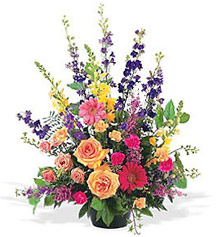Funeral Flowers
Common Questions & Advice

As florists, we work closely with families making funeral plans, friends and associates sending sympathy expressions, and funeral homes holding services. Flowers are an integral part of the funeral process. In fact, sympathy flowers have been part of funeral and memorial traditions in nearly every culture throughout history. For those less familiar with funeral flowers and sympathy etiquette, questions often arise. Here are some of the most common, along with sound advice from the Society of American Florists and our own expert designers.
Absolutely not. A funeral service is a way to honor someone's life, and bright, colorful flowers are a meaningful part of that tribute. In addition to adding beauty to an otherwise somber occasion, flowers provide a comforting diversion -- something to talk about or look at -- during the visitation. Of course, other color schemes are popular, too. Soft pinks, purples, and other pastels are appropriate for a feminine touch, while autumn tones have a more masculine theme. White, for peace, and red, for undying love, are also very popular at funerals and contrast well when combined.
Because flowers help you say what is often difficult to express, they are always appropriate and in good taste. Many people want to express sympathy and show respect for the deceased in a variety of ways, including charitable contributions, food donations, a helping hand, or cards and flowers. Flowers also play a functional role, adding warmth to the service and providing the visible, emotional support that the bereaved need during a difficult time. Funeral directors agree that most people do not want a service completely devoid of flowers.
To make your floral tribute particularly special, ask your florist to create an arrangement that fits the deceased's personality, for example, a rustic basket of wildflowers to honor someone who loved the outdoors. You could also include his or her favorite flowers or colors, or a flower that had special significance in your relationship with that person. Whatever you do, the family is sure to notice and appreciate it.
When groups, including grandchildren, nieces and nephews, friends, neighbors, business associates, and clubs go in together on flowers, the arrangements can be very special and make a larger showing. Such pieces can include standing sprays and wreaths. When sending flowers as a group, include a contact name and address on the card so the family knows whom to thank.
A tastefully done floral tribute adds beauty to any type of service, whether it's a traditional burial or a cremation. Because cremation is increasingly common in some areas, many florists will have specific suggestions. Families may choose a piece designed for display with the urn, or an arrangement that can be enjoyed in the home after the service.
A floral arrangement received at the home after the activity surrounding the funeral can be a comforting, welcome reminder that friends haven't forgotten. In fact, research shows that bereaved family and friends appreciate being thought of in the weeks or months after the funeral. A personal note or 'we are thinking of you' message with the flowers would be especially nice. Any support you can offer will let the family know you care.
Your florist is the expert, so you don't have to be. He or she will be happy to guide you. Still, here are some of the terms commonly used by florists, which may be helpful in your discussion.
- Wreath
- A floral presentation often used because a circle symbolizes eternal life.
- Spray
- Flowers designed for viewing from one side only. Sprays are often placed on an easel stand.
- Floral Arrangement
- An assortment of fresh flowers in a vase, basket or other container.
- Casket Spray
- Flowers designed for the top of the casket, usually ordered by the family.
- Inside Piece
- A general term to describe small floral designs placed inside the casket such as satin hearts, nosegays or small sprays.
